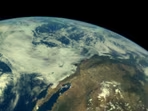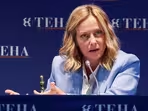Historic Investments and Accountability Push Chesapeake Bay Cleanup Efforts In Right Direction, Says EPA Mid-Atlantic Administrator
On a recent afternoon, Adam Ortiz, administrator of the U.S. Environmental Protection Agency’s Mid-Atlantic region office, and Bill Dennison, a professor and vice president at the University of Maryland Center for Environmental Science (UMCES), gathered to discuss a favorite, albeit complicated topic: the Chesapeake Bay.
Ortiz and Dennison were enthused about the latest Chesapeake Bay and Watershed report card, a yearly assessment of the bay’s health UMCES has issued since 2016. This year’s report card ranked the Bay’s overall health at a “C+”—a seemingly moderate score but the highest grade it’s received since 2002. “After decades of being stagnant, the bay effort is moving again in the right direction,” Ortiz said. “We stepped up our effort, including accountability, with historic investments and holding states accountable to doing their part.”
A healthier bay is good news for the EPA. A recently published paper in the Environmental Law Reporter cited agriculture and stormwater runoff from developed land as key reasons the Chesapeake Bay was not on target to meet the cleanup goals. The paper criticized the EPA for going soft on partner states even though it has the power, under the Clean Water Act, to get states to do a better job of controlling nutrient pollution entering the watershed.
Explore the latest news about what’s at stake for the climate during this election season.
Ortiz has a different perspective and reflected on the challenges complicating the Bay cleanup efforts, threats from new and emerging contaminants, and what’s next for the Chesapeake Bay Program beyond 2025 in a conversation with Inside Climate News.
This interview has been edited for length and clarity.
Why is it so difficult to control pollution entering the Bay from nonpoint sources?
It’s only very recently that states are getting serious about investing in nonpoint sources, whether it’s agriculture or stormwater. Virginia, for the first time, fully funded their cost share only last year. Pennsylvania established the program and funded it for the first time in 2022. So the level of commitment is finally catching up to what’s required. But historically, that had not been the case throughout the watershed. This is the type of policy and programming that only now we’re taking seriously, across the partnership.
In the case of stormwater, it’s about getting to the right scale and having adequate resources. Bay jurisdictions have only recently started properly funding stormwater systems. But we’re still catching up on more than a century’s worth of untreated impervious surface. That’s a lot of catching up to do. We’re just starting to learn where to put rain gardens and bioswales that capture and divert stormwater. The monitoring network is continuing to grow. That’s why we’re working with citizen groups and riverkeepers and others so we can expand. But we’re still learning how to handle nonpoint sources. It’s a very young science.

But literature is also clear that nutrient imbalance is primarily created by the amount of nutrients or intense fertilizer applied on farmlands. What has been done about that?
The population has been growing while the number of farms has been shrinking, so farms have had to become more intensive. Until recently, the states and the federal government have needed to help farmers control pollution at the sources. The good news is that it’s going in the right direction. There are two things that we’re doing. One is that we have serious investments for the first time to help fund the amount of conservation practices that are necessary. And second, investing in water quality monitoring to make sure that those efforts are going to the places where they’ll make the most impact.
The Chesapeake Bay Scientific and Technical Advisory Committee’s 2023 report pointed out that the focus on financial incentives for implementing only specific practices that benefit farm owners is not resulting in large pollution reductions. Can you speak to that?
We’ve been working with states and other partners to have more effective strategies for addressing nonpoint sources. One is getting beyond just voluntary action and focusing on places in a coordinated way to make an impact. Maryland has been piloting a Pay for Success program that focuses on outcomes. Pennsylvania has a similar program called Rapid Delisting Program, which is about making sure that all the farms and other pollution sources in a sub watershed are being addressed together instead of being scattershot. Historically, lack of coordination and strategic deployment has slowed down the effectiveness of conservation practices.
A recently published paper criticized the EPA for not using all of its powers under the Clean Water Act in nudging the states to take more stringent pollution control measures to achieve the Bay cleanup goals. Can you respond to that?
Within six months of me entering this job, we stepped up our enforcement and compliance activities substantially, and met with leaders throughout Pennsylvania to tell them about our more aggressive enforcement posture. We also engaged in other conversations with them about how Pennsylvania can make more progress. The result was a bipartisan agreement for Pennsylvania to establish a program focusing on small farms as well as other initiatives. So we’ve reprogrammed many of our grants to go to the places that need it the most. And a lot of it is upstream.
“We have to be tough. But it’s also important to show love. The love part solves things that enforcement can’t solve alone.”
We have a lot of tools in our toolbox. And we need to use all of them for the environmental challenges that we have, especially the Chesapeake Bay. We stepped up our enforcement in the Bay substantially across the board, from permit oversight to discharge violations at factories and industrial uses and wastewater treatment plants, among others. But we also really stepped up our partnership at the same time. We increased our grant making, technical assistance, bringing people together with scientists, municipalities and others in the partner states. Our level of engagement and technical assistance has made a difference.
The approach is to use all the tools in the toolbox in a policy of tough love. We have to be tough. But it’s also important to show love. The love part solves things that enforcement can’t solve alone. Like I said, the EPA only has regulatory authority over 2 percent of farms. If we’re going to figure that out, we have to do much, much more.
To some observers, your approach seems to be tilted more toward partnership than enforcement. And the oft-cited reason for that is political caution and not to upset the status quo.
Some of the concerns about us not using our powers are old. The previous administration was very different from the current administration and there’s significant policy differences. The previous administration scrubbed the words climate change from the lexicon of the agency. In this administration, we have fully stepped in and there’s no question that the trajectory has changed and things are accelerating for the better. The evidence I’ll point to is that all of the Bay partner states are stepping up and funding their programs, which are supported by farmers, and are at the table. And we have earned the highest grade for Bay restoration in almost a generation. That’s what happens when we do our job and work together.
A new and emerging threat from contaminants like PFAS is meanwhile rearing its head on top of the persisting nutrient pollution.
The EPA under President Joe Biden has been as aggressive as we possibly could on emerging contaminants, catching up for a lot of lost time. We’ve issued tougher rules on lead, copper and PFAS and we are focused on the points of delivery of those contaminants. So, principally, drinking water systems and superfund sites, because that’s where we have immediate control. And that’s where there’s a well-documented research concentration. But there’s still a lot more work to do.
In our PFAS action plan, there’s a hierarchy of additional rulemaking that we want to do to get to other sources. But we’ve got to focus on the delivery. And that’s why we’ve been focusing on drinking water systems. Because when it comes out of the tap, that’s the most exigent threat to human health. And this is expensive stuff, especially for smaller communities. But we have brought available funding and also matched it with the federal funding under the infrastructure law. And, and we hope to continue funding these efforts into the future beyond the infrastructure money runs out.
The Chesapeake Bay Program’s Beyond 2025 committee recently came out with its recommendations on how to achieve the Bay cleanup goals going forward. What is recommended?
We’re also building on a history of investing in green streets and in disadvantaged communities in particular. There’s no question that we’re moving very much in that direction. But a big focus of the Beyond 2025 effort is to have more large-scale and complementary projects in those places where we’re doing street infrastructure projects along with recreation projects, such as living shorelines. That’s where the asset meets human interaction. So we’ve already changed our grantmaking that way. And that’s the direction that we’ve been moving as an agency.
One of the big recommendations coming out of 2025 is that we’d be more strategic and focused on places where we can demonstrate an uplift. And taking newer concepts and best practices and making it part of our mainstream work in the partnership, but also committing to taking on the tough stuff. There’s a lot we have to figure out on nonpoint sources, for example, that we know we have to lean into that we don’t have all the answers yet.
Are you confident that all the jurisdictions will continue to stay in the Bay agreement and invest in the outcomes it envisages?
All the states are at the table and committed to the partnership. I have no indication to think otherwise. The Bay agreement is an exercise that’s above and beyond the Clean Water Act or anything that’s been attempted before. Everybody plays a part—the federal government and the states. We’re taking on challenges that we never foresaw, like climate change and population growth, and all of the systems that support it. So all of us have to hang in there and work together. Personally, I think we need to focus on being as smart, focused and strategic as possible on nonpoint sources. It’s been a historically overlooked sector and there are initiatives that are proving to be effective. But they have to be done at a larger scale. That said, the trajectory has changed in just a few short years and things are going in the right direction. We have to remain focused on continuing that progress.
About This Story
Perhaps you noticed: This story, like all the news we publish, is free to read. That’s because Inside Climate News is a 501c3 nonprofit organization. We do not charge a subscription fee, lock our news behind a paywall, or clutter our website with ads. We make our news on climate and the environment freely available to you and anyone who wants it.
That’s not all. We also share our news for free with scores of other media organizations around the country. Many of them can’t afford to do environmental journalism of their own. We’ve built bureaus from coast to coast to report local stories, collaborate with local newsrooms and co-publish articles so that this vital work is shared as widely as possible.
Two of us launched ICN in 2007. Six years later we earned a Pulitzer Prize for National Reporting, and now we run the oldest and largest dedicated climate newsroom in the nation. We tell the story in all its complexity. We hold polluters accountable. We expose environmental injustice. We debunk misinformation. We scrutinize solutions and inspire action.
Donations from readers like you fund every aspect of what we do. If you don’t already, will you support our ongoing work, our reporting on the biggest crisis facing our planet, and help us reach even more readers in more places?
Please take a moment to make a tax-deductible donation. Every one of them makes a difference.
Thank you,
David Sassoon
Founder and Publisher
Vernon Loeb
Executive Editor
Share this article
Disclaimer: The copyright of this article belongs to the original author. Reposting this article is solely for the purpose of information dissemination and does not constitute any investment advice. If there is any infringement, please contact us immediately. We will make corrections or deletions as necessary. Thank you.
Title:Historic Investments and Accountability Push Chesapeake Bay Cleanup Efforts In Right Direction, Says EPA Mid-Atlantic Administrator
Url:https://www.investsfocus.com




